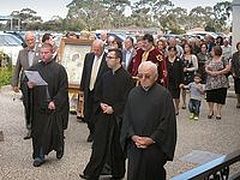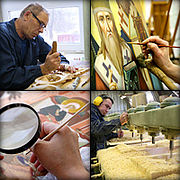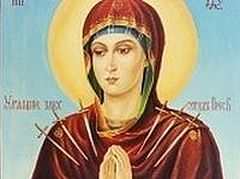SOURCE: Ohio.com
By Colette M. Jenkins
 Iconographer Filip Subotic puts the finishing touches on the icon wall at St. Demetrius Serbian Orthodox Church in Copley Twp. Photo: Phil Masturzo/Akron Beacon Journal
Iconographer Filip Subotic puts the finishing touches on the icon wall at St. Demetrius Serbian Orthodox Church in Copley Twp. Photo: Phil Masturzo/Akron Beacon Journal The vibrant images are more than art; they are instruments for transmitting Christian tradition and faith.
“The Holy Spirit speaks to us through the icons,” said Filip Subotic, the iconographer who created the paintings. “The icons enhance our spiritual experience by showing us the scriptures through images. They help build an atmosphere for prayer and worship.”
In late April, Subotic, who lives near Chicago, came to the Copley church to complete paintings on the walls and ceiling in the altar area. This week, he returned to install icons on the iconostasis — the screen or wall that separates the altar and the sanctuary.
On Sunday, all of the icons will be blessed at 9:30 a.m. by Bishop Mitrophan, leader of the Eastern American Diocese of the Serbian Orthodox Church, on the feast day of St. Demetrius, the church’s patron. The bishop will join St. Demetrius’ pastor, the Rev. George Mileusnich, in officiating at the 10 a.m. Divine Liturgy at the church, 3106 Ridgewood Road.
“This will be a special celebration for us. The fresco paintings and the icons have brought a warmth to the church that is inspiring people in their faith,” Mileusnich said. “The parishioners are happy. It really means a lot to the people.”
The 11 icons that were installed and gilded in gold leaf this week on the icon screen were created by Subotic in his native Belgrade (now Serbia), where he spent about five months working. He brought the images to the local church on canvas to install the iconostasis, which includes four doors.
The two center doors — called the Holy Doors, Royal Doors or Kingdom Doors — are reserved for entrance to the altar area by the bishop and priest when carrying the Gospel book or the chalice containing the holy Eucharist. The north and south doors are often called deacon’s doors. The south door is the liturgical entrance to the altar; the north door is the liturgical exit from the altar.
The images on the north end of the iconostasis are St. Sava (a Serbian prince, Orthodox monk and founder of Serbian law and literature); St. Demetrius (the patron saint of the local church who is recognized as a military and spiritual protector); Archangel Michael (defender of the faith) and the Mother of God with the Christ Child (representing the time of salvation). The icon of Archangel Michael is on the north door.
A depiction of the Annunciation — icons of Archangel Gabriel and the Mother of God (Virgin Mary) — is on the Holy Doors. Above the doors is an icon of the Last Supper.
The images on the south side of the iconostasis are Jesus the Lord, holding the Gospel book (representing wisdom and knowledge of God); St. Stephen (a deacon in the early church at Jerusalem) is on the south door); St. John the Baptist (prophet and baptizer of Jesus) and St. Nicholas (a Christian bishop who helped the needy).
“St. Nicholas, or Santa Claus” said Subotic, chuckling “is very important because he defended the Christian faith and really lived his convictions.”
Subotic, who has traveled across the nation since 2003 painting images in Orthodox churches, said the work provides a way for him to combine his studies in art and theology.
In addition to the icons on the iconostasis, Mitrophan will bless the paintings, similar to the artwork of Michelangelo, that Subotic completed earlier this year. Those images include a vibrantly colored icon of the Virgin Mary, Mother of God with the Christ Child, the focal point of the wall in the altar area; icons of prophets Enoch, Noah, Simon, Melchizedek, Aaron and Solomon; and an icon of Jesus on a cloth to represent the Shroud of Turin.
“These are holy pictures that are important to our faith,” Mileusnich said. “While we can enjoy their beauty, they have a deeper meaning: They are sacred images that proclaim the Gospel.”
More information about the Eastern American Diocese of the Serbian Orthodox Church can be found at www.easterndiocese.org.
Colette Jenkins can be reached at 330-996-3731 or cjenkins@thebeaconjournal.com. She can be followed at www.twitter.com/ColetteMJenkins.



